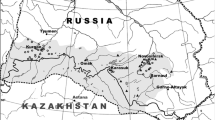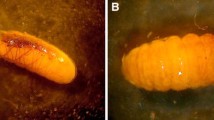Abstract
Ants are a major environmental factor for many insect species. For example, aphids and lycaenids have evolved an array of associations with ants ranging from obligate myrmecophily to the avoidance of contact. Here we (1) analyze the predictive power of different ecological and morphological traits for explaining the strength of the association between ants and aphids/lycaenids and (2) contrast different taxonomic levels with respect to the variance explained by ant attendance. Data come from a literature survey including 112 species of aphids and 103 species of lycaenids from Europe. For aphids, feeding on woody plant parts is positively associated with ant attendance, while a high degree of mobility, feeding in isolation, and the possession of wings in the adult stage are negatively associated with ant attendance. In lycaenids, feeding on inflorescences and feeding on Fabaceae host plants is closely associated with ant attendance, while living in forests bears a smaller likelihood to establish mutualistic relationships. Body size always appeared to be a poor predictor for the degree of ant attendance. Overall, in both insect groups less than 10% of the variation in the ecological traits recorded is explained by the different modes of ant association. When decomposing the variance in traits explained by ant attendance at different taxonomic levels, aphids and lycaenids show contrasting results. In aphids, most variance in the degree of ant attendance is explained at the subfamily level and least at the species level. The opposite is true for lycaenids, where most variance is explained at the lowest taxonomic level. Possible mechanisms explaining these different patterns of associations with ants are suggested.



Similar content being viewed by others
References
Axén AH, Pierce NE (1998) Aggregation as a cost-reducing strategy for lycaenid larvae. Behav Ecol 9:109–115
Baylis M, Pierce NE (1992) Lack of compensation by final instar larvae of the myrmecophilous lycaenid butterfly, Jalmenus evagorans, for the loss of nutrients to ants. Physiol Entomol 17:107–114
Bink FA (1992) Ecologische atlas van de dagvlinders van Noordwest-Europa. Schuyt, Haarlem, The Netherlands
Blackman RL, Eastop VF (1994) Aphids on the world's trees. CAB International, Wallingford, UK
Börner C (1952) Europae Centralis Aphides. Mitt Thüring Bot Ges, Beiheft 3, vols 1, 2. Weimar
Braby MF (2000) Butterflies of Australia. Their identification, biology and distribution. 2 vols, CSIRO Publishing, Collingwood
Bristow CM (1991) Why are so few aphids ant-tended? In: Huxley CR, Cutler DF (eds) Ant–plant interactions. Oxford University Press, Oxford, pp 104–119
Bronstein JL (1994) Our current understanding of mutualism. Q Rev Biol 69:31–51
Bronstein JL (2001) The exploitation of mutualism. Ecol Lett 4:277–287
Buckley RC (1987) Interactions involving plants, homoptera, and ants. Annu Rev Ecol Syst 18:111–135
Burghardt F, Fiedler K (1996) The influence of diet on growth and secretion behaviour of myrmecophilous Polyommatus icarus caterpillars (Lepidoptera: Lycaenidae). Ecol Entomol 21:1–8
Cushman JH, Beattie AJ (1991) Mutualism: assessing the benefits to hosts and visitors. Trends Ecol Evol 6:193–195
Cushman JH, Rashbrook VK, Beattie AJ (1994) Assessing benefits to both participants in a lycaenid–ant association. Ecology 75:1031–1041
Dixon AFG (1958) Escape response shown by certain aphids to the presence of the cocinellid Adalia decempunctata (L.). Trans R Entomol Soc Lond 10:319–334
Dixon AFG (1998) Aphid ecology. Chapman & Hall, London
Fiedler K (1991a) Systematic, evolutionary, and ecological implications of myrmecophily within the Lycaenidae (Insecta: Lepidoptera: Papilionidae). Bonn Zool Monogr 31:1–210
Fiedler K (1991b) European and North West African Lycaenidae and their associations with ants. J Res Lepid 28:239–257
Fiedler K (1995) Lycaenid butterflies and plants: is myrmecophily associated with particular hostplant preferences? Ethol Ecol Evol 7:107–132
Fiedler K (1998a) Geographical patterns in life-history traits of Lycaenid butterflies – ecological and evolutionary implications. Zoology 100:336–347
Fiedler K (1998b) Lycaenid–ant interactions of the Maculinea type: tracing their historical roots in a comparative framework. J Insect Conserv 2, 3–14
Fiedler K (2001) Ants that associate with lycaenid butterfly larvae: diversity, ecology and biogeography. Divers Distrib 7:45–60
Fiedler K, Hölldobler B (1992) Ants and Polyommatus icarus immatures – sex-related developmental benefits and costs of ant attendance. Oecologia 91:468–473
Fiedler K, Hummel V (1995) Myrmecophily in the brown argus butterfly, Aricia agestis (Lepidoptera: Lycaenidae): effects of larval age, ant number and persistence of contacts with ants. Zoology 99:128–137
Fiedler K, Maschwitz U (1989) The symbiosis between the weaver ant Oecophylla smaragdina and Anthene emolus, an obligate myrmecophilous lycaenid butterfly. J Nat Hist 23:833–846
Fisher MK, Shingleton AW (2001) Host plant and ants influence the honeydew sugar composition of aphids. Funct Ecol 15:544–550
Flatt T, Weisser WW (2000) The effects of mutualistic ants on aphid life-history traits. Ecology 81:3522–3529
Harley R (1991) The greasy pole syndrome. In: Huxley CR, Cutler DF (eds) Ant–plant interactions. Oxford University Press, Oxford, pp 430–433
Harvey PH, Pagel MD (1991) The comparative method in evolutionary biology. Oxford University Press, Oxford
Hayamizu E (1982) Comparative studies on aggregations among aphids in relation to population dynamics. I. Colony formation and aggregation behavior of Brevicoryne brassicae L. and Myzus persicae (Sulzer) (Homoptera: Aphididae). Appl Entomol Zool 17:519–529
Heie OE (1980) The Aphidoidea (Hemiptera) of Fennoscandia and Denmark. I) Fauna Entomol Scand 9:1–236
Heie OE (1986) The Aphidoidea (Hemiptera) of Fennoscandia and Denmark III. Fauna Entomol Scand 17:1–314
Heie OE (1987) Paleontology and phylogeny. In: Minks AK, Harrewijn P (eds) Aphids: Their biology, natural enemies, and control (2A). Elsevier, Amsterdam, pp 367–391
Heie OE (1992) The Aphidoidea (Hemiptera) of Fennoscandia and Denmark IV. Fauna Entomol Scand 25:1–189
Heie OE (1994) The Aphidoidea (Hemiptera) of Fennoscandia and Denmark V. Fauna Entomol Scand 28:1–242
Herre EA, Knowlton N, Mueller UG, Rehner SA (1999) The evolution of mutualism: exploring the path between conflict and cooperation. Trends Ecol Evol 14:49–53
Hesselbarth G, van Oorschot H, Wagener S (1995) Die Tagfalter der Türkei unter Berücksichtigung der angrenzenden Länder, 3 vols. Wagener, Bocholt
Higgins LG, Riley ND, Forster W (1978) Die Tagfalter Europas und Nordwestafrikas, 2nd edn. Parey, Hamburg
Hoeksema JD, Bruna EM (2000) Pursuing the big questions about interspecific mutualism: a review of theoretical approaches. Oecologia 125:321–330
Hölldobler B, Wilson EO (1990) The ants. Harvard University Press, Cambridge, Mass
Jolivet P (1996) Ants and plants: an example of coevolution (enlarged edition). Backhuys, Leiden, The Netherlands
Kloft WJ, Kunkel H (1985) Waldtracht und Waldhonig in der Imkerei. Ehrenwirth, Munich
Machado CA, Jousselin E, Kjellberg F, Compton SG, Herre EA (2001) Phylogenetic relationships, historical biogeography and character evolution of fig-pollinating wasps. Proc R Soc Lond Ser B 268:685–694
Martinez-Torres D, Buades C, Latorre A, Moya A (2001) Molecular systematics of aphids and their primary endosymbionts. Mol Phylogenet Evol 20:437–449
Mueller UG, Rehner SA, Schultz TR (1998) The evolution of agriculture in ants. Science 281:2034–2038
Normak BB (2000) Molecular systematics and evolution of the aphid family Lachnidae. Mol Phylogenet Evol 14:131–140
Offenberg J (2001) Balancing between mutualism and exploitation: the symbiotic interaction between Lasius ants and aphids. Behav Ecol Sociobiol 49:304–310
Pellmyr O, Leebens-Mack J (1999) Forty million years of mutualism: evidence for Eocene origin of yucca–yucca moth association. Proc Natl Acad Sci USA 96:9178–9183
Pierce NE (1985) Lycaenid butterflies and ants: selection for nitrogen fixing and other protein-rich food plants. Am Nat 125:888–895
Pierce NE (2002) Phylogeny and ecology of lycaenid/ant interactions. Proc 13th Eur Congr Lepidopterol, Korsør, p 49
Pierce NE, Elgar MA (1985) The influence of ants on the host plant selection by Jalmenus evagoras, a myrmecophilous lycaenid butterfly. Behav Ecol Sociobiol 16:209–222
Pierce NE, Kitching RL, Buckley RC, Taylor MFJ, Benbow K (1987) Costs and benefits of cooperation between the Australian lycaenid butterfly, Jalmenus evagoras and its attendant ants. Behav Ecol Sociobiol 21:237–248
Pierce NE, Braby MF, Heath A, Lohman DJ, Mathew J, Rand DB, Travassos MA (2002) The ecology and evolution of ant asociation in the Lycaenidae (Lepidoptera). Annu Rev Entomol 47:733–771
Punttila P (1996) Succession, forest fragmentation, and the distribution of wood ants. Oikos 75:291–298
Rosengren R, Sundström L (1991) The interaction between red wood ants, Cinara aphids, and pines. A ghost of mutualism past? In: Huxley CR, Cutler DF (eds) Ant–plant interactions. Oxford University Press, Oxford, pp 80–91
Sakata H (1995) Density-dependent predation of the ant Lasius niger (Hymenoptera: Formicidae) on two attended aphids Lachnus tropicalis and Myzocallis kuricola (Homoptera: Aphididae). Res Popul Ecol 37:159–164
Sandström J, Moran N (1999) How nutritionally imbalanced is phloem sap for aphids? Entomol Exp Appl 91:203–210
Scheurer S (1964) Zur Biologie einiger Fichten bewohnender Lachnidenarten (Homopter, Aphidina). Z Angew Entomol 53:153–178
Seufert P, Fiedler K (1996) Life-history diversity and local co-existence of three closely related lycaenid butterflies (Lepidoptera: Lycaenidae) in Malaysian rainforests. Zool Anz 234:229–239
Southwood TRE (1986) Plant surface and insects – an overview. In: Juniper BE, Southwood TRE (eds) Insects and the plant surface. Arnold, London, pp 1–22
Stadler B (2002) Determinants of the size of aphid–parasitoid assemblages. J Appl Entomol 126:258–264
Stadler B, Fiedler K, Kawecki T, Weisser W (2001) Costs and benefits for phytophagous myrmecophiles: when ants are not always available. Oikos 92:467–478
Stadler B, Dixon AFG, Kindlmann P (2002) Relative fitness of aphids: the effect of plant quality and ants. Ecol Lett 5:216–222
Sudd JH (1983) The distribution of foraging wood ants (Formica lugubris Zett.) in relation to the distribution of aphids. Insectes Soc 30:298–307
Ter Braak CJF, Looman CWN (1994) Biplots in reduced-rank regression. Biom J 36:983–1003
Ter Braak CJF, Šmilauer P (2002) CANOCO Reference manual and CanoDraw for Windows user's guide: software for canonical community ordination (version 4.5). Microcomputer Power, Ithaca, N.Y.
Thieme T, Müller FP (2000) Aphidina. In: Stresemann E (ed) Exkursionsfauna von Deutschland, vol 2, 9th edn. Spektrum Akad Verlag, Heidelberg, pp 169–237
Thompson JN (1994) The coevolutionary process. University of Chicago Press, Chicago, Ill
Tolman T, Lewington R (1998) Die Tagfalter Europas und Nordwestafrikas. Franckh-Kosmos, Stuttgart, 319 pp
Völkl W, Woodring J, Fischer M, Lorenz MW, Hoffmann KH (1999) Ant–aphid mutualism: the impact of honeydew production and honeydew sugar composition on ant preferences. Oecologia 118:483–491
Way MJ (1963) Mutualism between ants and honeydew-producing Homoptera. Annu Rev Entomol 8:307–344
Yao I, Akimoto S (2001) Ant attendance changes the sugar composition of the honeydew of the drepanosiphid aphid Tuberculatus quercicola. Oecologia 128:36–43
Yao I, Akimoto S (2002) Flexibility in the composition and concentration of amino acids in honeydew of the drepanosiphid aphid Tuberculatus quercicola. Ecol Entomol 27:745–752
Acknowledgements
Three anonymous reviewers helped to improve the manuscript. Financial support was provided to BS by the German Ministry for Research and Technology (Fördernummer: BMBF No. PT BEO 51-0339476D) and to PK by MSMT grant No. MSM 123100004. KF's work on myrmecophilous Lycaenidae was supported by the Deutsche Forschungsgemeinschaft (Fi 547/1-1, 1-2, Grako 678).
Author information
Authors and Affiliations
Corresponding author
Rights and permissions
About this article
Cite this article
Stadler, B., Kindlmann, P., Šmilauer, P. et al. A comparative analysis of morphological and ecological characters of European aphids and lycaenids in relation to ant attendance. Oecologia 135, 422–430 (2003). https://doi.org/10.1007/s00442-003-1193-8
Received:
Accepted:
Published:
Issue Date:
DOI: https://doi.org/10.1007/s00442-003-1193-8




